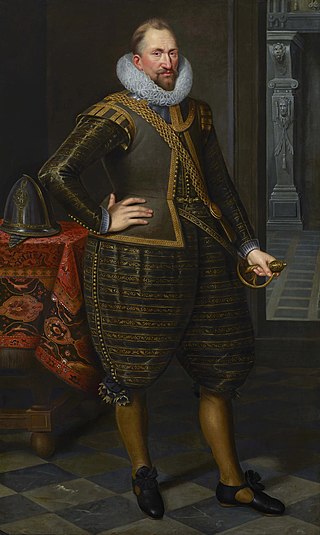
The Compagnie van Verre (meanings "long-distance company") was one of the forerunner companies that were later merged (united) into the Dutch East India Company.

The Compagnie van Verre (meanings "long-distance company") was one of the forerunner companies that were later merged (united) into the Dutch East India Company.
It was set up in 1594 by nine citizens of Amsterdam, to break Portugal's monopoly on the pepper trade. To do this, it sent an expedition of three heavily armed ships and a pinnace under the leadership of Cornelis de Houtman, with orders to break into the trade. (Cornelis' brother Frederik also worked for the company.) On 2 April 1595 the ships set off from Texel, with 248 officers and men on board. The expedition (which became known as the Eerste schipvaart) followed the routes described by Jan Huygen van Linschoten after he had made the journey in the pay of the Portuguese. On 6 June 1596 the ships arrived at Bantam, the most important pepper port on Java. During the return trip, on 11 January 1597, the Amsterdam was badly damaged and had to be left behind at the island of Bawean. On 14 August 1597 the expedition arrived back in Amsterdam with only 87 survivors. The voyage was not a success commercially, but it proved that not only the Portuguese had the potential to trade in pepper.
In 1598 the Compagnie van Verre merged with the Nieuwe Compagnie and in 1597 with the Oude Compagnie . The resulting company then merged with the Nieuwe Brabantsche Compagnie in 1601 to form the Verenigde Amsterdamse Compagnie , which in turn merged with many other companies (including the Verenigde Zeeuwse Compagnie ) in 1602 into the Dutch East India Company (VOC), retaining a room in the VOC's chambers in Amsterdam.

The Dutch West India Company or WICDutch pronunciation:[ʋɛstˈɪndisəkɔmpɑˈɲi] was a chartered company of Dutch merchants as well as foreign investors, formally known as GWC. Among its founders were Reynier Pauw, Willem Usselincx (1567–1647) and Jessé de Forest (1576–1624). On 3 June 1621, it was granted a charter for a trade monopoly in the Dutch West Indies by the Republic of the Seven United Netherlands and given jurisdiction over Dutch participation in the Atlantic slave trade, Brazil, the Caribbean, and North America.

The United East India Company and commonly known as the Dutch East India Company, was a chartered trading company and the first joint-stock company in the world. Established on 20 March 1602 by the States General of the Netherlands existing companies, it was granted a 21-year monopoly to carry out trade activities in Asia. Shares in the company could be bought by any resident of the United Provinces and then subsequently bought and sold in open-air secondary markets. The company possessed quasi-governmental powers, including the ability to wage war, imprison and execute convicts, negotiate treaties, strike its own coins, and establish colonies. Also, because it traded across multiple colonies and countries from both the East and the West, the VOC is sometimes considered to have been the world's first multinational corporation.

Cornelis de Houtman was a Dutch merchant seaman who commanded the first Dutch expedition to the East Indies. Although the voyage was difficult and yielded only a modest profit, Houtman showed that the Portuguese monopoly on the spice trade was vulnerable. A flurry of Dutch trading voyages followed, eventually leading to the displacement of the Portuguese and the establishment of a Dutch monopoly on spice trading in the East Indies.

Willem Cornelisz Schouten was a Dutch navigator for the Dutch East India Company. He was the first to sail the Cape Horn route to the Pacific Ocean.
The Eendracht was an early 17th century Dutch wooden-hulled 700 tonne East Indiaman, launched in 1615 in the service of the Dutch East India Company (VOC). Its Dutch name means "concord", "unity" or "union", and was a common name given to Dutch ships of the period, from the motto of the Republic: Concordia res parvae crescunt . The ship was captained by Dirk Hartog when he made the second recorded landfall by a European on Australian soil, in 1616.

Rijcklof Volckertsz. van Goens was the Governor of Zeylan and Governor-General of the Dutch East Indies. He was the Governor of Zeylan from 12 May 1660 to 1661, then in 1663 and finally from 19 November 1664 to 1675 during the Dutch period in Ceylon. He was also served as Council Member of India during 1679. Van Goens’ managed to monopolize the cinnamon trade, get hold of the Malabar pepper and drive away the Portuguese from Ceylon and the Coromandel Coast for the VOC.

Gerard Reynst was a Dutch merchant and later the second Governor-General of the Dutch East Indies.
Thirteen ships of the Dutch East India Company and its pre-companies have been named Amsterdam.

Steven van der Hagen was the first admiral of the Dutch East India Company (VOC). He made three visits to the East Indies, spending six years in all there. He was appointed to the Raad van Indië. Van der Hagen protested against the harsh administration of the administrators, who wanted a monopoly on the clove trade and were willing to fight against their Spanish, Portuguese, English or Asiatic trade competitors in order to get it. Laurens Reael and Steven van der Hagen wrote with disapproval on how the Heren XVII treated the interests and laws of the Maluku population.

The Brabant Company, also known as the New Company, was a precursor of the Dutch East India Company (VOC).

Isaac Le Maire was a Dutch entrepreneur, investor, and a sizeable shareholder of the Dutch East India Company (VOC). He is best known for his constant strife with the VOC, which ultimately led to the discovery of Cape Horn.

Paulus van Caerden was a Dutch admiral in service of the Dutch East India Company. He was governor of the Maluku Islands for one month.

The First Dutch Expedition to the East Indies was an expedition that took place from 1595 to 1597. It was instrumental in opening up the Indonesian spice trade to the merchants that eventually formed the Dutch East India Company, and marked the end of the Portuguese Empire's dominance in the region.

Gerrit Pieter Bicker (1554–1604) was a Dutch merchant, patrician, and one of the founders of the Compagnie van Verre and its successor the Dutch East India Company.
Balthazar de Moucheron was a Dutch trader, ship owner and one of the founders of the Dutch East India Company, but never participated as he went bankrupt in the same year. He is known for his early trading with India (Calcutta) and Indonesia, America, the west coast of Africa, the Baltic Sea and the White Sea (Archangelsk).

A voorcompagnie (pre-company) is the name given to trading companies from the Republic of the Seven United Netherlands that traded in Asia between 1594 and 1602, before they merged to form the Dutch East India Company (VOC). The pre-companies were financed by merchants from the Northern Netherlands and rich immigrants from the Southern Netherlands. Because of the deadly competition, the government forced the smaller trading companies to unite and form the (United) East India Company. In its turn, it received the exclusive rights for the trade with Asia for the following 21 years.

The Compagnie van De Moucheron was a pre-company and precursor of the Verenigde Oost Indische Compagnie, from the Republic of the Seven United Netherlands. It was founded by Balthazar de Moucheron, a ship owner from Antwerp in the Southern Netherlands. After the fall of Antwerp he moved his business to Zeeland. The fleet of the Compagnie van De Moucheron was made up of three ships, 'Ram', 'Schaap' (Sheep) and the pinasse 'Lam' (Lamb) and was headed by Joris van Spilbergen. Its fleet left on 5 May 1601 and returned to the Republic of the Seven United Netherlands in 1604.

The Veerse Compagnie was a pre-company from the Republic of the Seven United Netherlands that was founded by Balthazar de Moucheron, a ship owner from Antwerp in the Southern Netherlands. After the fall of Antwerp he moved his business to Zeeland. The fleet of the Veerse Compagnie was made up of two ships; 'Leeuw' (Lion) and 'Leeuwin' (Lioness) and was headed by Cornelis Houtman. Its fleet left from Veere on 28 March 1598 and returned to the Republic of the Seven United Netherlands in 1600.

Reyer or Reynier Pauw, was an influential Amsterdam regent of the Golden Age. Pauw was pensionary and eight times mayor of Amsterdam. He was involved in the Compagnie van Verre, the VOC, and the trial of Johan van Oldenbarnevelt.

The Old Company was a pre-company of the Dutch Republic and originated from the Company of Verre and the New Company, from Amsterdam, in 1598. The directors were Dirck van Os, Jan Hermansz, Jan Janss Carel (Kaerel) and Geraerdt (Gerrit) Bicker. Directors with a smaller share of the investment were: Vincent van Bronckhorst, Symon Jansz Fortuyn, Geurt Dircxz, Cornelis van Campen, Jacob Thomasz Van den Dael, Elbert Simonsz Jonckheyn, Petrus Plancius, Syvert Sern, Jan Poppe, Geurt Dirckss and Pieter Hasselaer. The Old Company and the (New) Brabant Company would merge in 1601 and become the United Amsterdam Company.